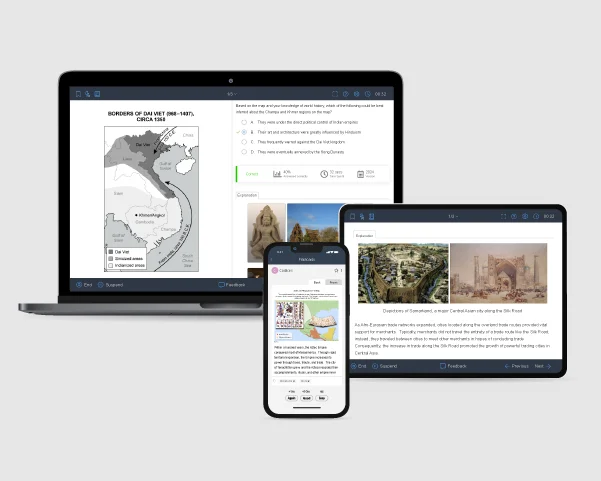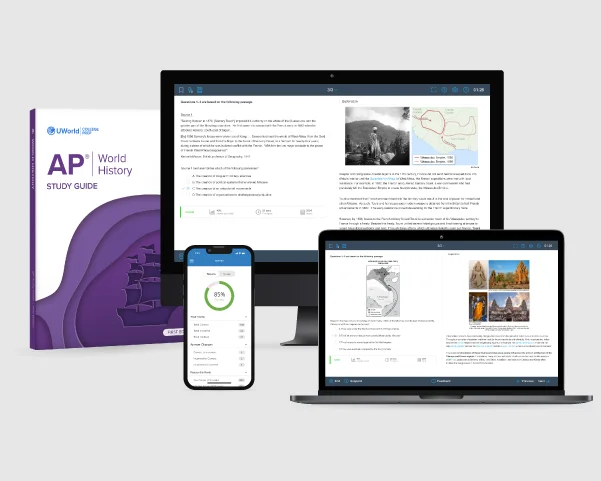How Is the AP World History Exam Scored?
The AP World History exam is typically scored on a scale of 1 to 5, with 5 being the highest score. The scoring process involves two main sections:
Section I of the AP World History exam includes 55 multiple-choice (MCQs) and three short-answer (SAQs) questions and makes up 60% of the overall score. There is no penalty for wrong answers, so take a guess even if you are unsure of the answer.
Section II includes one document-based (DBQ) and one long essay (LEQ) question, which is 40% of the overall score. Let's take a quick look at how the exam is graded. As with all other AP exams, the final scaled score for AP World History will be between 1 and 5. Your raw scores are a cumulation of your scores from each section (MCQ, SAQ, DBQ, and LEQ).
| Section | Part | Question Type | Raw Points |
|---|---|---|---|
| Section I | Part A | 55 MCQs | ~55 points |
| Part B | 3 SAQs | 9 points | |
| Section II | Part A | 1 DBQ | 7 points |
| Part B | 1 LEQ | 6 points |

Section I scoring pattern
As you may already know, Section I of the APWH exam consists of MCQs and SAQs. Each of these question types is graded under a specific rubric. Let’s learn more about the AP World History grading scale:
-
Part A: Multiple-choice question
For the multiple-choice questions, you get one point for each correct answer, and the maximum number of points you can earn on this part is 55.
Keep in mind that this section accounts for 40% of your overall score. Incorrect answers do not deduct points, so be sure to fill in every answer bubble.
-
Part B: Short answer question
Each short-answer question (labeled A-C) is worth 3 points. So, you can earn a total of 9 raw points for your responses to the three short-answer questions. This part accounts for 20% of your APWH score.
Section II scoring pattern
Section II includes a DBQ and an LEQ that require you to write free-response answers to the questions prompted. Both these question types are graded on how you establish your answer based on a line of reasoning, context, and evidence. Let’s learn more about the AP World History grading scale for the DBQs and LEQs:
-
Document-based question
25% of your final grade will be based on your performance on the DBQ, which is evaluated on the 7-point rubric shown below. The following table will give you a better idea of how the raw scores in this section are distributed.
Reporting Category Points Scoring Criteria Thesis/Claim
(0–1 point)1 pt Responds with a historically defensible thesis or claim and a line of reasoning. Contextualization
(0–1 point)1 pt Gives a broad historical context for the prompt. Evidence
(0–3 points)Evidence from the documents
1 pt
+
Evidence beyond the documents 1 ptIf your response addresses the prompt by using at least three documents
+You need to use at least one piece of historical evidence (beyond the documents) to argue about the promptEvidence from the documents
2 pts
+
Evidence beyond the documents 1 ptIf your answer supports an argument with six documents
+You need to use at least one piece of historical evidence (beyond the documents) to argue about the promptAnalysis and Reasoning
(0–2 points)Sourcing
1ptRespond to the prompt using at least three documents to explain why a document's viewpoint, purpose, historical context, or audience is relevant to an argument. Complexity
1ptTo answer this prompt, use evidence to corroborate, qualify, or modify an argument that answers the question. -
Long essay question
15% of your final grade is based on the LEQ, which is graded using the 6-point rubric explained below. You can see how the raw scores for this section are distributed in the table below.
Reporting Category Points Scoring Criteria Thesis/Claim
(0–1 point)1 pt Responds to the prompt with a historically defensible thesis or claim. Contextualization
(0–1 point)1 pt Provides relevant historical context. Evidence
(0–2 points)1 pt Provides prompt-related evidence. 2 pts Responds to the prompt with specific, relevant evidence. Analysis and Reasoning
(0–2 points)1 pt Uses historical reasoning (e.g. comparison, causation, continuity, and change) to address the prompt. 2 pts Uses evidence to corroborate, qualify, or modify an argument that answers the question.
Craft a solid thesis and develop strong arguments with the help of our Study Guide, specifically designed for the AP World History exam.
AP World History Scoring Table
Your total exam score is weighted into a final score of 1 to 5. Each score reflects a specific performance. These scores are developed after a lot of research that the College Board® conducts. Colleges use these scores to decide who gets free credit and placement. Students need a score of 3 or more to qualify for college credit. You can choose to send your score report to colleges through the College Board. To learn more about how to send your scores to the colleges of your choice, read our guide to AP Scores.
The main aim of AP World History is to teach you foundational history at the college level right in high school. Hence, the board ensures that a student’s performance, measured by their final score on the APWH exam, can be correlated to a college student’s performance in a college-level history course.
The AP score table below shows how scores are converted into equivalent college grades for the AP World History: Modern exam.
| AP Exam Score | College Grade Equivalent | Qualification |
|---|---|---|
| 5 | A+ or A | Extremely well qualified |
| 4 | A-, B+, or B | Well qualified |
| 3 | B-, C+, or C | Qualified |
| 2 | — | Possibly Qualified |
| 1 | — | No recommendation |
As you can see, a score of less than 3 does not imply a good college grade. On the APWH exam, a score of 4 or 5 is considered excellent. Always double-check the minimum requirements of the colleges to which you intend to apply.
Set yourself up for success with our all-inclusive AP World History prep course, crafted to guide you through every step of the exam preparation process.
AP World History Score Distribution
The AP World History exam score distribution can vary from year to year, and it depends on the performance of all test takers.
Here are the AP World History score distributions for the last three years:
| AP Score | % of Students 2024 | % of Students 2023 | % of Students 2022 | % of Students 2021 |
|---|---|---|---|---|
| 5 | 11.9% | 15.3% | 13.2% | 9.7% |
| 4 | 32.3% | 21.9% | 21.9% | 18.5% |
| 3 | 19.6% | 27.4% | 27.0% | 24.0% |
| 2 | 27.4% | 22.3% | 23.7% | 28.9% |
| 1 | 8.8% | 13.0% | 14.3% | 19.0% |
| 3+ | 63.7% | 64.7% | 62.1% | 52.2% |
AP World History is one of the most popular social studies AP courses. While the popularity of a course can influence the score distribution, it's important to note that the College Board uses a statistical process known as "equating" to ensure that scores are fair and consistent from year to year. This process adjusts for differences in test difficulty and ensures that the scores accurately reflect a student's performance relative to other test-takers. Ultimately, the goal is to maintain the integrity of the AP scoring system regardless of a course's popularity.
Minimum Score Requirement for College Credits
Passing the AP World History exam with a score of 3 or higher can earn you up to six hours of college credit. Most US colleges accept AP scores for credit or advanced placement. However, some schools require a 4 or a 5 to grant these credits. Some colleges offer both advanced placement and credit, which means you will get the credits while also skipping the course.
Each college has different AP score requirements. It is important to know the college entrance requirements for AP World History while preparing for the exam.
To learn why taking the AP World History exam is beneficial to your career, read our AP World History: Modern Exam guide.
Frequently Asked Questions
What is a good AP World History score?
A good AP World History score is typically a 3 or higher. A 5 on your AP World History exam is unquestionably the best possible score. However, if you get a score of 3 to 5, you will be eligible for college placement and credits.
What is the average AP World History score?
The average AP World History exam score in 2024 is 3.11, an increase from 3.04 in 2023.
Why are AP World History scores curved?
The AP World History scores are curved to ensure consistency and standardization across exams given on paper, digital media, and at different times. This ensures AP exam scores translate to equivalent college grades.
When is the AP World History exam date for 2025?
The exam date for AP World History: Modern is scheduled for Thursday, May 8, 2025 at 12 p.m. local time.
How do I get a 5 on the AP World History exam?
To achieve a score of 5 on the AP World History exam, you need to thoroughly prepare and demonstrate a strong understanding of the course material. It is important to practice exam-like questions and the free-response question rubric. To boost your confidence, increase your knowledge, and prepare for the AP World History exam, follow these five steps.
- To determine your level of knowledge, take a practice test. Try UWorld’s APWH QBank.
- Make a study plan (and stick to it) ahead of time for your exam.
- Use an online learning tool that includes exam-style practice questions and comprehensive explanations.
- Keep track of your progress to see where you’re succeeding and where you need to improve.
- Exam prep begins with practice. It allows you to compare your answers to those that have already been graded.
References
- AP World history modern course and exam description. (n.d.). Retrieved January 3, 2025, from https://apcentral.collegeboard.org/pdf/ap-world-history-modern-course-and-exam-description.pdf?course=ap-world-history-modern
- Past AP World History: Modern Score Distributions - College Board. (n.d.). Retrieved January 3, 2025, from https://apstudents.collegeboard.org/about-ap-scores/score-distributions/ap-world-history
- AP Score Distributions – AP Students | College Board. (n.d.). Retrieved January 3, 2025, from https://apstudents.collegeboard.org/about-ap-scores/score-distributions
- AP World History: Modern Exam – AP Central | College Board. (n.d.). Retrieved January 3, 2025, from https://apcentral.collegeboard.org/courses/ap-world-history/exam

Read More About the AP World History Exam
Learn everything about your exam long before exam day with this valuable exam guide. Review tips, what's on the exam, who can take it, and all the essential FAQs—it’s all there.
AP World History Modern Exam FormatUnderstanding the exam format is a game-changer! Check out this easy guide to the AP World History exam format, including its components, question types, duration and more.
AP World History Modern CEDCurious about the units, topics, and key concepts on the APWH exam? Explore our concise summary of the Course and Exam Description to find everything you need to know.
Best AP World History Prep Course ReviewDiscover the best APWH prep courses with our detailed review. Find top resources, expert tips, and study strategies to prepare efficiently and boost your chances for success!
AP World History Study Guide ComparisonCompare the best AP World History study guides to find the perfect fit for your learning style. Explore comprehensive reviews and key features to help you ace the exam!
How to Self-Study for AP World HistoryLearn how to effectively self-study for APWH with expert tips, proven strategies, and helpful resources. Master key concepts, improve your skills, and boost your exam performance.



